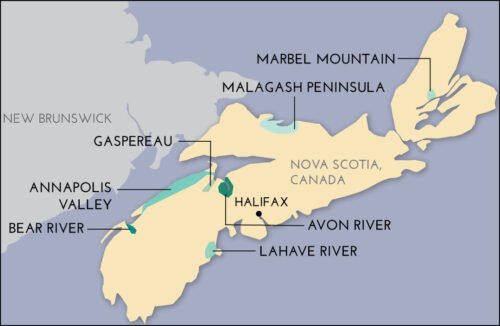Nova Scotia is a province located on the eastern coast of Canada, bordered by the Atlantic Ocean. It is known for its maritime culture, stunning coastline, and burgeoning wine industry. Its name, “New Scotland” in Latin, reflects its historical ties to Scotland.
The history of grape cultivation and winemaking in Nova Scotia traces back to the early 1600s when French settlers arrived. These settlers likely brought grapevines and planted the first vineyard in Bear River. This location appears to have been chosen for the microclimate offered by the inland area. The twice-a-day flushing of the Bay of Fundy tides into and out of the Annapolis Basin and upstream to Bear River creates a type of natural heat bank, mitigating extremes in weather and temperature.
The provinces’ next recorded vineyard was planted in 1633 in Petite Riviere. These early plantings confirm Nova Scotia’s position as one of the oldest New World wine regions. However, it wasn’t until the late 20th century that the modern wine industry in Nova Scotia began to flourish. In the 1970s and 1980s, interest in grape growing and winemaking in Nova Scotia was resurgent. Experimentation with grape varieties suited to the region’s climate and soil conditions led to the establishment of the province’s first commercial vineyards and wineries. One of these pioneering vineyards was Domaine de Grand Pré, established in the Annapolis Valley in 1979, marking the beginning of Nova Scotia’s contemporary wine industry.
Whilst Nova Scotia doesn’t have recognised regional GI’s, there are seven identifiable grape-growing regions in the province:
The heart of Nova Scotia’s wine industry is the Annapolis Valley, known for its cool climate and fertile soils, particularly conducive to growing grapes like L’Acadie Blanc, Chardonnay, and Pinot Noir. Within the larger Annapolis Valley region, the Gaspereau Valley has gained recognition for producing high-quality cool-climate wines, especially aromatic whites like Riesling and Gewürztraminer. Another sub-region of the Annapolis Valley, the Avon River Valley, benefits from a similar climate and is home to several vineyards and wineries.
Located in northern Nova Scotia, the Malagash Peninsula is known for its coastal vineyards, which benefit from the moderating influences of the nearby Northumberland Strait. Cape Breton Island, to the east, is not as well-known for wine production as some other regions, but it has a few vineyards that benefit from its unique climate, which is influenced by the surrounding ocean.
Along Nova Scotia’s South Shore, the LaHave River Valley boasts a growing number of vineyards, taking advantage of its microclimate and proximity to the Atlantic Ocean.
Last but by no means least is the Bear River Valley. This area, near the Bay of Fundy, has a microclimate that supports grape growing, primarily in sheltered pockets along the river valley.
Wineries across the state
Click here to find out more about the wineries in this region and to search for specific criteria.
Top Stats
Number of Regions
7 grape growing regions
Number of Wineries
~20
Area of planted vine
~485 hectares
Source: Wines of Nova Scotia



